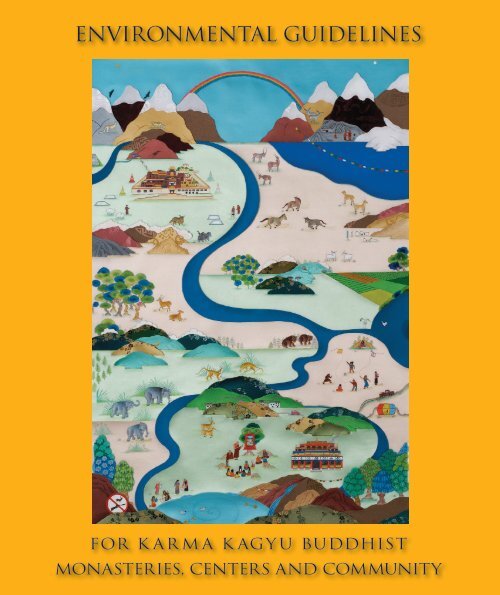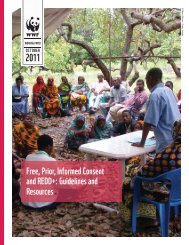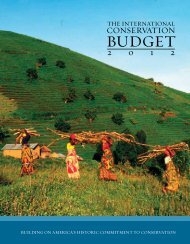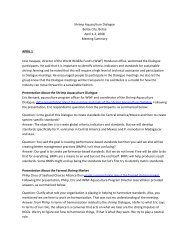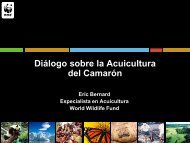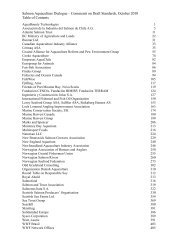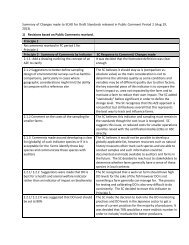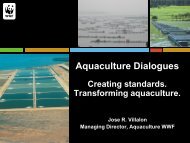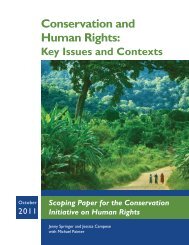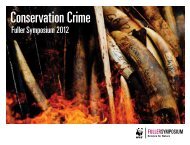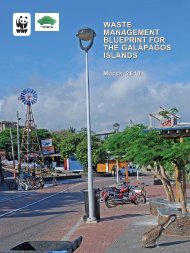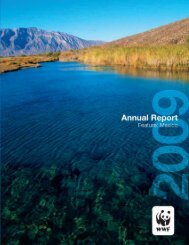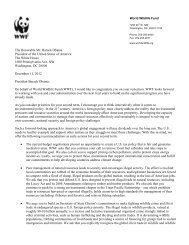ENVIRONMENTAL GUIDELINES - World Wildlife Fund
ENVIRONMENTAL GUIDELINES - World Wildlife Fund
ENVIRONMENTAL GUIDELINES - World Wildlife Fund
Create successful ePaper yourself
Turn your PDF publications into a flip-book with our unique Google optimized e-Paper software.
<strong>ENVIRONMENTAL</strong> <strong>GUIDELINES</strong><br />
FOR K AR M A K AGY U BUDDHIST<br />
MONASTERIES, CENTERS AND COMMUNITY
Contents<br />
Pages<br />
Foreword by His Holiness, the Seventeenth Karmapa 1<br />
Introduction 3<br />
Acknowledgements<br />
These guidelines were made possible through<br />
the contributions of the following:<br />
Dekila Chungyalpa, <strong>World</strong> <strong>Wildlife</strong> <strong>Fund</strong>, who<br />
provided assistance and advice in the development<br />
of the guidelines. May her efforts bring benefit to all<br />
sentient beings.<br />
Leslie and Terris Nguyen Temple, who painted the<br />
cover thangka and illustrated the text. May their work<br />
continue to highlight and restore the legacy of Tibetan<br />
Buddhist art.<br />
The translators who produced the different versions<br />
of these guidelines so that they are easy to use by the<br />
monastic community and the wider sangha.<br />
The many editors and advisors who provided<br />
practical suggestions and improvements for the<br />
guidelines.<br />
People all over the world who work to raise<br />
awareness, protect the environment, and build<br />
harmonious values.<br />
Section 1: Forest Protection 6<br />
Section 2: Water Protection 10<br />
Section 3: <strong>Wildlife</strong> Protection 13<br />
Section 4: Waste Management 16<br />
Section 5: Addressing Climate Change 19<br />
Conclusion 23<br />
© 2008 His Holiness the Seventeenth Gyalwang Karmapa,<br />
Ogyen Drodul Trinley Dorje<br />
Material from this book can be used freely but<br />
please acknowledge the source<br />
Layout and design by Somchai Singsa<br />
Printed at Archana, New Delhi<br />
www.archanapress.com<br />
<strong>ENVIRONMENTAL</strong> <strong>GUIDELINES</strong> ...
Foreword<br />
In the past, people in most parts of the world had a very straightforward relationship with the<br />
environment. They used the resources provided by nature as needed and due to the simplicity of their<br />
lives, rarely did great damage to the Earth. However, this has changed considerably in more recent<br />
times. Not only are our lives no longer so simple, our relationship with the environment is much more<br />
complicated and we now have tremendous power to do it harm.<br />
Our lifestyle in the 21 st century makes huge demands on the environment. We use more and more<br />
resources like fossil fuels, timber and water without any understanding of what the outcomes will be.<br />
We think we need all kinds of gadgets, toys and machines without stopping to think if these are really<br />
important and useful to us. Sometimes there seems to be no natural limit to human desires. But there<br />
is a limit to how much Mother Earth can sustain us and we cannot afford to indulge in our desires<br />
unthinkingly.<br />
During the time of the Buddha, the monastic community lived carefully and frugally and nothing was<br />
wasted. I have read that when new robes were offered to the monks, the old robes were used to cover<br />
their cushions and mattresses. When those covers wore out, the cloth was used as dusters and finally<br />
when even that wore out it was mixed with clay and used to plaster the walls.<br />
The Buddha followed a way of life that did not fall into either of two extremes-utter poverty and suffering<br />
on the one hand or accumulation and hoarding on the other. Monks lived from day to day with no<br />
need to store food and resources and such a lifestyle accorded with the middle way. The Buddha didn’t<br />
want a monk’s life to be very difficult, but neither did he encourage the hoarding of offerings from the<br />
faithful. Similarly, today our lifestyle should be neither too hard nor overly indulgent.<br />
When writing about the Bodhisattva vow, Chandragomen said:<br />
For others and also for yourself,<br />
Do what is useful even if painful,<br />
And what is both useful and pleasurable,<br />
Not what gives pleasure but is of no use.<br />
So, if something we want brings benefit but does not harm us or the environment, then we can think<br />
of it as necessary. But, if that is not the case, we should certainly think twice about why we want it and<br />
if we need it at all.<br />
Still, this is something that individuals must weigh up and choose for themselves. Making this kind of<br />
active decision means that you are making a choice with some confidence and not just blindly. In this<br />
way you can match your actions to your aspirations.<br />
... FOR KARMA KAGYU BUDDHIST MONASTERIES, CENTERS AND COMMUNITY<br />
1
I was born in 1985, in a very remote area without modern amenities. As a result, I grew up experiencing<br />
the old way of life as it had been led for centuries in Tibet. People were very careful about how they used<br />
water, wood, and other resources. I don’t remember there being any garbage because people found a<br />
use for everything. They were careful to not spoil the springs from which they took their drinking water.<br />
In fact, I remember that as a child I planted a tree to protect our local spring and asked my father to look<br />
after it once I left for Tsurphu.<br />
People in my homeland may not have much formal education but we have inherited a deep traditional<br />
concern for the environment. Even the children regard many of the mountains and rivers in their<br />
landscape and some of the wild animals as sacred and treat them with respect accordingly. This is part<br />
of their family heritage and our cultural tradition.<br />
These days, however, I hear there is a move for nomads to settle down and become farmers. The traditional<br />
way of life is rapidly fading away. The communities that are settling down use more resources; they cut<br />
a lot more trees and they generate a lot more garbage, which needs to be disposed of. Farming means<br />
that the grasslands themselves will disappear and maybe the soil itself will not be able to sustain this<br />
lifestyle without more and more fertilizers and chemicals.<br />
Many of these aspects of life are similar throughout the Himalayan region. The Tibetan Plateau and the<br />
Himalayan region are especially important because they are the watershed for much of Asia; therefore<br />
I hope that the people who live here can set an example of how to take care of the environment. Many<br />
of the people in this region are Buddhist, and have a respect for the Buddha dharma. I hope that their<br />
faith and devotion will be a source of practical benefit for all beings and bring peace and harmony in the<br />
world. Otherwise our prayers for the welfare of all sentient beings will not be much more than words of<br />
consolation.<br />
We have already done such immense damage to the environment that it is almost beyond our power to<br />
heal it. As a small step, I requested during the 25 th Kagyu Monlam in 2007 that environmental protection<br />
and community service be incorporated into the program. Climate change is having a direct effect on<br />
our lives here in this region, more than most places. Therefore, I advised all the monasteries and the<br />
wider public with whom I have a connection to engage actively wherever they could to protect the<br />
environment.<br />
Building on this, and combining the Buddhist tradition and our respectful attitude to the environment<br />
with contemporary science and practices, I have directed the following guidelines. They are but a small<br />
drop in a huge ocean. The challenge is far more complex and extensive than anything we alone can<br />
tackle. However, if we can all contribute a single drop of clean water, those drops will accumulate into a<br />
fresh pond, then a clear stream and eventually a vast pure ocean. This is my aspiration.<br />
Written by the Seventeenth Karmapa, Ogyen Drodul Trinley Dorje, at Gyuto Monastery in Dharamsala on<br />
October 1 st 2008<br />
2 <strong>ENVIRONMENTAL</strong> <strong>GUIDELINES</strong> ...
Introduction<br />
Our ancestors viewed the earth<br />
as rich and bountiful, which it<br />
is. Many people in the past also<br />
saw nature as inexhaustibly<br />
sustainable, which we now<br />
know is the case only if we<br />
care for it. It is not difficult to<br />
forgive destruction in the past<br />
that resulted from ignorance.<br />
Today however, we have access<br />
to more information, and it is<br />
essential that we re-examine<br />
ethically what we have inherited,<br />
what we are responsible for, and<br />
what we will pass on to coming<br />
generations.<br />
[His Holiness, the Dalai Lama]<br />
... FOR KARMA KAGYU BUDDHIST MONASTERIES, CENTERS AND COMMUNITY<br />
3
Aspiration<br />
As dharma practitioners, we want to turn the wheel of dharma so that all living beings can<br />
be freed from suffering. Wherever there is suffering, we wish to transform it into happiness<br />
and equanimity.<br />
Dependent Arising<br />
We know that our sense of self is misleading. In fact, what is self is not independent from<br />
the rest of life around us. The food we eat, the clothes we wear, and the books we read are<br />
produced by other living beings. Even the source of the air we breathe is elsewhere and not<br />
within us.<br />
Interdependence<br />
This understanding of interdependence makes us aware that all of life is connected and that<br />
our individual actions have immediate consequences in the larger world. This cause and<br />
effect is karma. Natural catastrophes around the world are extensive and on the rise. Every<br />
day, we hear of floods, hurricanes, and droughts and watch people suffer as a result. Much of<br />
this suffering is caused by or worsened by human activity and puts the entire planet at risk.<br />
As dharma practitioners we have a responsibility to reverse negative actions through skillful<br />
means so that there is a healthy and balanced future for all life.<br />
Buddhism & the Environment<br />
Buddhism has a long tradition of environmental protection. Buddha taught the concepts of<br />
interdependence, of cause and effect, of karma, and of dharma values (Pratītyasamutpāda).<br />
Most dharma practitioners want to contribute positively to preserving the environment, but<br />
unless we all work together, no solution will be found. Moreover, although we have begun to<br />
learn lessons from what has already taken place, good wishes alone are not enough to bring<br />
about change. We have to assume active responsibility.<br />
4 <strong>ENVIRONMENTAL</strong> <strong>GUIDELINES</strong> ...
Environmental Guidelines for Karma Kagyu Buddhist<br />
Monasteries, Centers and Community<br />
The suggestions contained in these guidelines attempt to focus the widespread concern<br />
felt throughout Tibet and the Himalayan region about the decline in the state of the natural<br />
environment and the clear signs of climate change impacts. They offer reliable information<br />
in the hope that readers will develop a fresh perspective, especially one that emphasizes<br />
practical action. Based on assessments of environmental problems facing us in this region,<br />
five thematic areas are presented: Forests, Water, <strong>Wildlife</strong>, Waste and Climate Change.<br />
Forests Protection: Forests are necessary for life-both human and animal. Monasteries<br />
can protect them through reforestation, and minimizing grazing and over-harvesting<br />
in degraded areas.<br />
Water Protection: The rivers in Tibet and the Himalayas give life to hundreds of<br />
millions of people in Asia. They should be protected from pollution, landslides and<br />
floods, which are caused by roads and deforestation. Monasteries, especially in river<br />
source areas, can lead in environmental protection of water resources.<br />
<strong>Wildlife</strong> Protection: <strong>Wildlife</strong>, especially large Asian cats like tigers and leopards are<br />
directly threatened by the illegal wildlife trade. Monasteries can discourage ornamental<br />
use of furs by local communities, as well as ban hunting in their vicinity.<br />
Waste Management: For environmental, aesthetic and health purposes, monasteries<br />
can encourage better management of waste and prevention of pollution-not only on<br />
their own lands, but also in the larger community.<br />
Addressing Climate Change: The impact of climate change is being strongly felt in<br />
Asia and most strongly on the Tibetan plateau where the glaciers that feed the major<br />
Asian river systems are in rapid retreat. To reduce the impacts, monasteries can lead<br />
communities in using renewable energy and energy efficiency.<br />
Monasteries and centers should assess which of these thematic areas and guidelines are<br />
most applicable to them and follow the guidelines accordingly.<br />
... FOR KARMA KAGYU BUDDHIST MONASTERIES, CENTERS AND COMMUNITY<br />
5
1 FOREST PROTECTION<br />
Trees have a great significance in Buddhism.<br />
Buddha Shakyamuni was born as his mother<br />
leaned on a tree, he became enlightened seated<br />
under the Bodhi tree and he finally passed away<br />
lying down between two Sal trees. The forests<br />
in Tibet and the Himalayas are particularly rich<br />
and plentiful, and around the world they play an<br />
important life-giving role. They provide millions<br />
of people with wood for fuel, timber for building<br />
houses, fodder for animals, and food and medicine.<br />
They are home for amazing wildlife such as tigers,<br />
elephants, bears, leopards, a variety of birds that<br />
nest among their trees, and a huge diversity of<br />
amphibians and insects.<br />
6 <strong>ENVIRONMENTAL</strong> <strong>GUIDELINES</strong> ...
Forests have another very important<br />
purpose: they are part of a natural cycle that<br />
provides clean water and clean air. Earth’s<br />
atmosphere is made of oxygen, carbon and<br />
nitrogen gases. Each breath that we take in<br />
is made up of oxygen. When we breathe out,<br />
we exhale carbon dioxide. Trees, on the other<br />
hand, take in carbon dioxide and breathe out<br />
oxygen. In one year, an average tree inhales<br />
12 kilograms of carbon dioxide and exhales<br />
enough oxygen for a family of four. Forests are<br />
essential for transforming and storing carbon<br />
dioxide emissions produced by humans.<br />
Since trees also absorb and hold water for<br />
long periods, forests provide a lot of moisture<br />
in the air. When this moisture evaporates, it<br />
doesn’t disappear, but condenses into clouds<br />
which eventually result in rain. This is why<br />
forests regulate water flow in the area and<br />
can help control floods. They also reduce<br />
soil erosion because their roots are able to<br />
keep large amounts of soil in place. This is<br />
especially important in the mountain areas of<br />
the Himalayas and the Tibetan Plateau where<br />
there are a lot of floods and landslides.<br />
As problems caused by pollution and climate<br />
change continue to grow, protecting our forests<br />
is one of our few chances to restore a natural<br />
balance.<br />
What is the problem?<br />
Sadly, forest loss is taking place at a rapid<br />
rate. In Tibet, deforestation is driven mainly<br />
by logging for timber. In the past, logging was<br />
sustainable because communities were small.<br />
However, in the last fifty years, many billions<br />
of dollars worth of Tibetan timber have<br />
been extracted. As more and more nomadic<br />
communities are settled by the authorities, local<br />
demand for timber will continue to rise. Most<br />
forestry authorities rely on the trees’ ability to<br />
grow back but the rate of natural regeneration<br />
cannot keep up with the demand for timber.<br />
In the mid-Himalayan range, the biggest<br />
threats to forests are caused by expansion of<br />
agricultural lands into forests, and over-use<br />
of fuel wood and other forest products. In<br />
the lower lying areas of the Himalayas, overgrazing<br />
of livestock is the largest threat.<br />
What can we do about it?<br />
It is important that we think of forests as a finite<br />
resource that must be used sustainably. If we<br />
don’t act accordingly and protect them, they<br />
will disappear and leave people much poorer<br />
than they are now. Natural regeneration is no<br />
longer sufficient as a strategy and we need to<br />
actively plant trees and reforest barren lands.<br />
But the most important thing is to prevent the<br />
excessive cutting of trees in the first place.<br />
... FOR KARMA KAGYU BUDDHIST MONASTERIES, CENTERS AND COMMUNITY<br />
7
<strong>GUIDELINES</strong> FOR<br />
FOREST PROTECTION<br />
Plant trees to restore forests: Monasteries in<br />
historically forested areas should plant trees<br />
on degraded monastery-owned lands or<br />
community lands. Monasteries should make<br />
an attempt to select trees that already grow in<br />
the surrounding area. This is important because<br />
choosing native tree species will make them<br />
part of the natural landscape and increase their<br />
chances of survival. When planting many trees,<br />
it is best to plant a variety of different types.<br />
Protect existing forests from over-harvesting<br />
of products: Forests usually provide plenty of<br />
resources for poor nearby communities. This<br />
includes everything from fuel wood, honey, and<br />
medicines, to straw and fodder. But many forests<br />
suffer because too much is taken out without<br />
giving the forest a chance to recover. This leaves<br />
everyone with too little. Monasteries should<br />
encourage sustainable extraction of these<br />
resources.<br />
8 <strong>ENVIRONMENTAL</strong> <strong>GUIDELINES</strong> ...
Prevent excessive deforestation: Monasteries<br />
in rich forested areas should be careful to<br />
manage the forests on their lands. They<br />
should not carry out indiscriminate logging<br />
and should try to harvest trees so that the<br />
forest itself is not destroyed.<br />
Protect grasslands in high altitude areas: Many parts of the Tibetan Plateau<br />
are not forested but consist of grasslands and rangelands that are the<br />
fundamental basis of livelihoods for Tibetan nomadic communities.<br />
The combination of over-grazing and agricultural expansion (especially<br />
to grow barley) is eroding this type of habitat very quickly. Tibetans<br />
mistakenly believe that small animals like the pikas are degrading the<br />
pastures. However, this is not the case. The over-abundance of pikas is<br />
actually a symptom of over-grazed grasslands and due to the killing of the<br />
wild predators who feed on these animals. Monasteries should educate<br />
communities about the capacity of grasslands so that communities<br />
keep fewer and healthier livestock rather than large herds that are not<br />
as healthy. Traditional practices of community pasture management are<br />
still the best way to manage grasslands from a sustainable perspective.<br />
Limit grazing in forested land: Monasteries should<br />
limit the number of cattle that graze on forested<br />
lands and especially in the Himalayan low lands<br />
where grazing is destroying the vegetation. Fencing<br />
off some of these groves will help regenerate the<br />
forests, and improve biodiversity. Areas that are<br />
fenced off can be rotated so that each forest area is<br />
used two out of every three years and left to recover<br />
for at least one year.<br />
... FOR KARMA KAGYU BUDDHIST MONASTERIES, CENTERS AND COMMUNITY<br />
9
2 WATER PROTECTION<br />
Water is the source of life; without it we<br />
cannot survive. Yet, it is often the resource we<br />
take most for granted. We waste it in areas where<br />
it is abundant, we throw garbage into rivers, we<br />
dump pesticides, fertilizers, and toxic chemicals<br />
into streams and lakes, and oil spills occur all<br />
over the Earth’s oceans. Of all the water on<br />
Earth, only 2.5 percent is drinkable-fresh waterand<br />
is found in rivers, lakes and streams. Tibet<br />
is the source for most of the major rivers in Asia<br />
including the Brahmaputra, the Ganges, the<br />
Indus, the Irrawaddy, the Mekong, the Salween,<br />
the Yangtze, and the Yellow River. These rivers<br />
provide drinking water, irrigation and food<br />
across the regions they flow through. Polluting<br />
the rivers near the source or destroying the river<br />
system upstream means that fish will disappear<br />
from the rivers downstream and the people who<br />
depend on freshwater for their livelihoods will<br />
be unable to survive.<br />
10 <strong>ENVIRONMENTAL</strong> <strong>GUIDELINES</strong> ...
What is the problem?<br />
The rivers of the Himalayas and the Tibetan<br />
plateau are regarded as sacred because they<br />
give life to hundreds of millions of people<br />
before they reach the sea. Unfortunately,<br />
many river ecosystems are now threatened by<br />
sewage and industrial pollution, deforestation<br />
of watersheds, degradation of natural fisheries<br />
and sometimes by construction of hydroelectric<br />
dams whose environmental impact has not<br />
been correctly assessed. Furthermore, the<br />
rapid rate of climate change on the Tibetan<br />
plateau is causing glaciers to retreat rapidly.<br />
These glaciers are the ‘reservoirs in the sky’<br />
for Tibet’s-and therefore Asia’s-great rivers.<br />
Glacial melt water is an essential component<br />
of river flow in the Ganges, Indus, Yellow and<br />
Yangtze rivers, which can also explain the<br />
increase of flooding in recent years.<br />
What can we do about it?<br />
It is our duty to protect the Tibetan glaciers<br />
in the north. This is the only way to keep the<br />
great Asian rivers free flowing and clean, not<br />
only for our benefit but also for the millions of<br />
people who depend on them downstream. It<br />
is important to see a river basin as one living<br />
system and understand that what happens in one<br />
part of the river will be felt in another part. We<br />
must take responsibility to educate ourselves<br />
about the interdependent relationship between<br />
glaciers, water ecosystems, and human activity<br />
and to share this knowledge as widely as<br />
possible among those who can either influence<br />
or be impacted by this phenomenon.<br />
... FOR KARMA KAGYU BUDDHIST MONASTERIES, CENTERS AND COMMUNITY<br />
11
<strong>GUIDELINES</strong> FOR WATER PROTECTION<br />
Protect river sources: If a monastery is situated<br />
near the source of a river, it should protect<br />
the area as much as possible.<br />
This means that steps should<br />
be taken to prevent pollution<br />
from pipes, canals and cities<br />
(municipal wastewater) being<br />
dumped into rivers that are used<br />
for drinking water. Communities<br />
should be discouraged from<br />
dumping their waste into rivers<br />
and simple alternatives should<br />
be provided instead. These<br />
include starting composting of<br />
organic waste, and collecting<br />
garbage through a communal<br />
waste management scheme (see<br />
Waste Management section).<br />
Clean up programs for rivers<br />
and lakes: Monasteries and<br />
centers can be at the heart of<br />
community based clean-ups by<br />
raising awareness of the impacts of littering and dumping<br />
waste in rivers. Monasteries can organize clean-up days<br />
where volunteers pick up trash near river beds, lake areas,<br />
and canals, especially those that are used as drinking<br />
sources.<br />
Understand, share knowledge, advocate: Understand and share<br />
knowledge of the integrated relationship between Himalayan<br />
glaciers, water problems in Asia, and human activity as they<br />
influence this relationship. There is an important analogy<br />
between the status of Tibet and the Arctic. Both are key<br />
elements that reflect the state of the world’s climate and both<br />
are ‘tipping points’ in global warming. If we are to avoid future<br />
catastrophes in Asia, we must act together to protect Tibet<br />
and slow down the rate of glacier loss. This issue goes beyond<br />
politics, for it is a matter of mutual survival.<br />
Manage manure and fertilizer use:<br />
Animal waste, pesticides, and fertilizers are<br />
often carried by rain run-off into<br />
nearby rivers and lakes. There are<br />
some simple ways to minimize<br />
this type of pollution. Farmers<br />
can use less pesticides and<br />
fertilizers, especially in high slope<br />
or mountainous areas where<br />
they are more likely to wash<br />
off into the rivers in the valleys<br />
below. Farmers can also create<br />
vegetation buffers between farm<br />
fields and rivers by planting trees<br />
and grasses that can absorb and<br />
filter out the toxic substances<br />
from water before it reaches<br />
rivers and canals. Monasteries<br />
can promote these kinds of<br />
environmental management<br />
approaches on and nearby their<br />
own lands.<br />
Maintain wetlands: Wetlands are<br />
often ignored or drained by<br />
people who want to use the land<br />
for farming. However, wetlands<br />
have a very important purpose.<br />
They serve as a natural filter for<br />
wastes and garbage and because<br />
of the special combination of<br />
insects and plants that they<br />
host; they purify the water that<br />
comes through them before it<br />
enters a river or a lake. Protecting<br />
and maintaining wetlands will<br />
improve the quality of water in<br />
rivers and lakes immensely.<br />
12 <strong>ENVIRONMENTAL</strong> <strong>GUIDELINES</strong> ...
3<br />
WILDLIFE PROTECTION<br />
<strong>Wildlife</strong> refers to all the animals, birds, fish,<br />
reptiles, and insects that live in the wilderness.<br />
Their diversity and uniqueness is what makes up<br />
the biodiversity of our planet. Sadly, their numbers<br />
decrease day by day because of our actions and soon<br />
many of them will only be found in zoos. Just as we<br />
have parents and we wish nothing but good for them,<br />
we should feel similarly towards wildlife species that<br />
are sentient beings and part of our larger family.<br />
Millions and millions of species exist on Earth. (By<br />
contrast, all human beings of all races make up only<br />
one species.) Many of these species are insects! It<br />
is easy to think that just because a species is very<br />
small, it does not have any value. However, every<br />
species has a specific purpose in nature-even a lowly<br />
earthworm inching in the ground makes the soil<br />
richer just by its existence. Biodiversity benefits us<br />
in the form of food, shelter, and medicine, as well<br />
as revenue from ecotourism which allows tourists<br />
to appreciate wildlife and wilderness areas without<br />
threatening them.<br />
... FOR KARMA KAGYU BUDDHIST MONASTERIES, CENTERS AND COMMUNITY<br />
13
What is the problem?<br />
The United Nations Environment Programme<br />
and many senior biologists state that due to loss<br />
of habitats and climate change, we may lose a<br />
quarter to a half of all species by the year 2050.<br />
The Himalayan belt and the Tibetan Plateau<br />
make up an area where large numbers of animal,<br />
plant and bird species are clustered together. As<br />
a result, the region has a very high biodiversity<br />
value globally. This value is declining quickly,<br />
partly due to illegal hunting and trade in wildlife<br />
products which targets species like tigers,<br />
leopards, elephants and chiru, making them<br />
endangered. Traditionally, local people would<br />
hunt to meet their needs without depleting the<br />
wildlife populations that sustained them. Today,<br />
professional hunters come to remote areas and<br />
target endangered animals so that they can sell<br />
their skins or bones commercially. Wild animals<br />
are no longer hunted for food but for fashion (tiger<br />
and leopard fur), traditional medicine (tiger parts<br />
and bear bile), and exotic restaurants (turtles and<br />
snakes).<br />
What can we do about it?<br />
During the 2006 Kalachakra Empowerment at<br />
Amaravati, His Holiness the Dalai Lama said:<br />
“When you go back to your respective places,<br />
remember what I had said earlier and never<br />
use, sell, or buy wild animals, their products or<br />
derivatives.” Stopping the illegal wildlife trade<br />
means protecting the remaining wildlife, so<br />
that their populations can be sustained into the<br />
future. All Tibetan Buddhists should follow his<br />
instruction.<br />
Discourage use of traditional medicine that<br />
includes illegal animal products: Many<br />
traditional medicines use ingredients that<br />
come from a variety of animals and plants<br />
including wild ginseng and musk deer. While<br />
some of the wildlife products are legal, the<br />
demand for endangered animal parts causes<br />
illegal wildlife trade to flourish. As much as<br />
possible, people should use alternatives to<br />
traditional medicines with illegal animal<br />
products in them. In particular, people<br />
should avoid medicines with tiger and bear<br />
products.<br />
14 <strong>ENVIRONMENTAL</strong> <strong>GUIDELINES</strong> ...
<strong>GUIDELINES</strong> FOR<br />
WILDLIFE PROTECTION<br />
Protect wild habitat: One of the<br />
biggest threats to wildlife is habitat<br />
destruction. If there is no place for<br />
them to live, how can they survive?<br />
It is important to set aside lands<br />
reserved only for wild species and to<br />
protect these areas.<br />
Become well-informed: Become educated<br />
and well-informed about the issue of<br />
species loss and extinction. As Mahayana<br />
Buddhists, we have a special duty to ensure<br />
that this Earth, and the many species with<br />
which we share it, are healthy as much and<br />
as long as possible. We can still save two<br />
out of every three species on Earth and this<br />
must be our common Buddhist position.<br />
Promote No Hunting Zones: All monasteries<br />
should strongly discourage any hunting<br />
on monastic lands and nearby common<br />
lands. This can be achieved by informing<br />
local communities, raising information<br />
signs on monastery lands, and monitoring<br />
areas where illegal hunting occurs.<br />
Prohibit wearing of ornamental fur from<br />
endangered animals: Tiger, leopard and<br />
otter skins are being illegally poached<br />
from all parts of Asia, and many of them<br />
end up in the Tibetan areas of Sichuan,<br />
Qinghai and Gansu. There, people<br />
sometimes use them as decoration. In<br />
keeping with His Holiness the Dalai Lama’s<br />
edict, monasteries and centers should<br />
strongly discourage the illegal trade and<br />
wearing of ornamental fur and skins.<br />
... FOR KARMA KAGYU BUDDHIST MONASTERIES, CENTERS AND COMMUNITY<br />
15
4 WASTE MANAGEMENT<br />
Pollution is caused by the unmindful disposal of<br />
waste onto the ground or into rivers and lakes. Due to<br />
a lack of proper waste management in the Himalayas<br />
and the Tibetan plateau, pollution is becoming a big<br />
problem. Historically, most communities used organic<br />
materials made of plant products. With modernization<br />
came a shift to using materials like plastic, glass, and<br />
aluminum. Such materials are synthetics which mean<br />
that they do not degrade easily in the environment and<br />
often release harmful chemicals into the air as they<br />
degrade, which leads to long-term pollution.<br />
16 <strong>ENVIRONMENTAL</strong> <strong>GUIDELINES</strong> ...
What is the problem?<br />
If people drink or eat fish from rivers<br />
and ponds that have been polluted, they<br />
become sick. Freshwater is often polluted by<br />
sewage when people dump toilet wastes and<br />
household garbage into it, or when industries<br />
release contaminated and toxic wastes into it.<br />
Often, diseases such as diarrhea and typhoid<br />
are caused by bacteria found in sewage or<br />
household garbage. The major source of air<br />
pollution is the smoke released from coal-fired<br />
power stations, car and truck exhausts, which<br />
is why people who live in large industrial<br />
cities often suffer from breathing ailments<br />
such as asthma. Therefore, it is important to<br />
keep in mind that pollution and health issues<br />
are closely connected.<br />
What can we do?<br />
There are three simple rules to reduce waste,<br />
and these are known as the 3Rs:<br />
• Reduce: Use fewer things on a daily<br />
basis.<br />
• Reuse: Instead of throwing away things<br />
like plastic bottles and bags, reuse them<br />
for storage.<br />
• Recycle: Collect and sort or segregate<br />
materials like paper, plastic, glass and<br />
metals to be converted into new products.<br />
Traditionally in Tibet and the Himalayas,<br />
almost everyone practiced the 3 Rs as a way<br />
of life. These days, people are less likely to do<br />
so. Not only can monasteries become leaders<br />
to implement these rules, they can also work<br />
more directly to improve waste management<br />
in their communities. In addition, monasteries<br />
can work with local community based<br />
organizations to set up communal waste<br />
management schemes that use the guidelines<br />
presented on the following page.<br />
... FOR KARMA KAGYU BUDDHIST MONASTERIES, CENTERS AND COMMUNITY<br />
17
<strong>GUIDELINES</strong> TO MINIMIZE<br />
POLLUTION AND MANAGE WASTE<br />
Create a clean environment:<br />
Provide garbage disposal bins<br />
for different kinds of waste<br />
on monastery grounds and<br />
in surrounding communities<br />
to collect organic (i.e. food<br />
scraps) and inorganic waste.<br />
Compost organic materials: Collect<br />
food scraps and plant materials to<br />
create compost that can be applied<br />
to monastic vegetable gardens.<br />
Compost keeps soil rich and moist,<br />
reducing the need for artificial<br />
fertilizers.<br />
Create safe storage: Store<br />
inorganic waste materials<br />
(i.e. plastic and metals), far<br />
from water sources like<br />
rivers and lakes. Collect them<br />
periodically to send them to<br />
nearby towns for reuse or<br />
recycling.<br />
Reduce the use of plastic: Plastics can<br />
take up to a thousand years to break<br />
down naturally and are toxic when they<br />
do decompose. When light plastics<br />
such as plastic bags and wrappings are<br />
thrown away carelessly, they are easily<br />
dispersed by the wind. If they end up<br />
at sea, or in rivers and lakes, they can<br />
suffocate species including fish and<br />
turtles. On land they endanger wild and<br />
domestic animals that try to eat them.<br />
18 <strong>ENVIRONMENTAL</strong> <strong>GUIDELINES</strong> ...
5<br />
ADDRESSING<br />
CLIMATE CHANGE<br />
The Earth’ s climate has altered several times<br />
over hundreds of millions of years with major ice<br />
ages and several large scale global warming events.<br />
For example, 55 million years ago, the release of huge<br />
volumes of natural gas from beneath the ocean caused<br />
a “runaway” global warming event that destroyed<br />
most of the species on Earth. However, recent human<br />
activities are so extreme that climate variations are<br />
taking place very frequently and forcefully, and no<br />
longer in a balanced way.<br />
Our climate has been stable for the last 12,000<br />
years and this is what has allowed the development<br />
of human agriculture and civilization to take place.<br />
However, the Industrial Revolution which started in<br />
the 18th century led to the extraction and burning of<br />
fossil fuels and therefore large releases of carbon gas<br />
into the atmosphere. The continuation of this type of<br />
industrial economic growth remains the root cause of<br />
climate change now taking place.<br />
... FOR KARMA KAGYU BUDDHIST MONASTERIES, CENTERS AND COMMUNITY<br />
19
What is the problem?<br />
The dependence on fossil fuels for energy is<br />
caused by the need to power industrial growth,<br />
agricultural development, and consumerdriven<br />
economic growth. The burning of fossil<br />
fuels and the cutting down and burning of trees<br />
has led to an overall increase of heat-trapping<br />
gases in the Earth’s atmosphere. These gases,<br />
also known as greenhouse gases, create a<br />
barrier which prevents heat from escaping our<br />
atmosphere. Over the years, the earth’s surface<br />
temperature has continued to rise, especially<br />
as other countries, like India and China, have<br />
started industrializing. The warmest years in<br />
human history have all been since 1998. If this<br />
trend continues, many species will become<br />
extinct and life on Earth as we know it will<br />
come to an end.<br />
Climate change is already a dangerous threat<br />
in the high altitude areas of the Himalayas and<br />
the Tibetan Plateau. In the short term, many<br />
of the lakes and wetlands in the mountains<br />
will swell due to melting glaciers leading to<br />
the overflowing of lakes and flash floods. This<br />
can have catastrophic effects in remote areas<br />
as people will not have access to medicine,<br />
safe drinking water and other necessities. In<br />
the long term, water, agriculture, forestry,<br />
fisheries, the whole Tibetan ecosystem and<br />
age-old way of life are all endangered by the<br />
climate breakdown.<br />
What can we do about it?<br />
The bad news is that we are already<br />
experiencing many changes in rainfall and<br />
snowfall patterns and temperature increases.<br />
Scientists are pointing out the rising frequency<br />
of storms and floods, droughts and fires caused<br />
by climate change.<br />
However, it is human activity that is causing<br />
this to happen, changing our behavior can<br />
avert many of these impacts. Experts agree that<br />
the average rise in temperature of the Earth’s<br />
surface must not grow above another 2˚C,<br />
beyond which there will be severe irreversible<br />
changes. We must do all we can, as one<br />
global community, to minimize energy use,<br />
change our energy sources from fossil fuels to<br />
renewable energy, and stop deforestation.<br />
20 <strong>ENVIRONMENTAL</strong> <strong>GUIDELINES</strong> ...
<strong>GUIDELINES</strong> FOR MITIGATING CLIMATE CHANGE<br />
Use fuel-efficient stoves: Now, with new<br />
technology available in India and Nepal, it is<br />
quite affordable to use fuel efficient stoves that<br />
require less wood or coal for fuel but produce<br />
more energy. Similarly, monasteries can invest in<br />
biogas stoves, which are relatively cheap. These<br />
stoves use methane generated by<br />
human or animal waste, a good<br />
source of energy. Another<br />
important (but more<br />
expensive) option for<br />
generating hot water<br />
is to install rooftop<br />
solar panels in high<br />
mountainous areas<br />
where there is a<br />
consistent supply<br />
of sunlight.<br />
Minimize<br />
the collective<br />
carbon footprint:<br />
Monasteries can<br />
minimize their collective<br />
use of energy and reduce<br />
their “carbon footprint” ( the<br />
accumulated amount of carbon<br />
gas released into the atmosphere as a<br />
result of activities like driving cars and trucks,<br />
using electricity and other energy sources).<br />
A carbon-neutral lifestyle can be attained<br />
by conserving energy and using alternative<br />
energy sources. Centers that cannot go<br />
carbon neutral can offset their carbon use<br />
by planting trees or restoring forests either<br />
on their own lands or in forest areas in the<br />
Himalayas and Tibet.<br />
Design energy efficient buildings: Many monastic<br />
buildings are built to be large and impressive but<br />
not to be efficient in terms of size and building<br />
materials i.e. concrete and marble in cold climates.<br />
Examples of sustainable building designs include<br />
the use of proper insulation for walls and<br />
roofs that prevent heat from<br />
escaping, allowing natural<br />
light to illuminate the<br />
building so that less<br />
electricity is needed,<br />
planting certain tree<br />
species around the<br />
buildings so that<br />
air circulation is<br />
fostered during<br />
warm weather<br />
and heat is<br />
conserved<br />
during cold<br />
weather.<br />
Eat less meat or<br />
become completely<br />
vegetarian: In simplest<br />
terms, food is energy<br />
and the food that requires<br />
the least amount of energy<br />
to produce is vegetarian:<br />
grains, vegetables, pulses, fruits<br />
and so on. Animals that live on plants<br />
take energy from the earth. Those of us who eat meat<br />
take up even more energy than these animals. People<br />
should consider giving up meat not only to practice<br />
compassion for animals, but also to reduce the burden<br />
they are putting on the Earth. All Kagyu monasteries<br />
practice vegetarianism--they should also encourage<br />
individuals to cultivate compassion for all living things<br />
and lighten the load the Earth already carries.<br />
... FOR KARMA KAGYU BUDDHIST MONASTERIES, CENTERS AND COMMUNITY<br />
21
<strong>GUIDELINES</strong> FOR ADAPTATION<br />
IN HIGHLY VULNERABLE AREAS<br />
Develop emergency relief<br />
plans: In areas that are<br />
likely to be affected<br />
by glacial melting,<br />
landslides, or even<br />
flooding, monasteries<br />
should reach out to<br />
emergency relief, health<br />
and environmental<br />
non-governmental<br />
organizations to set up<br />
disaster management<br />
plans within their<br />
communities.<br />
Plan new construction<br />
carefully: Monasteries<br />
can also set up<br />
partnerships to assess<br />
where best to build<br />
new constructions-for<br />
example, establish the<br />
projected flooding line<br />
on mountain slopes<br />
above rivers.<br />
Monitor changes carefully:<br />
Many NGOs and<br />
government bodies<br />
are tracking impacts<br />
of climate change and<br />
have set up projects<br />
that monitor them.<br />
Monasteries in areas<br />
like the Kanchenjunga<br />
tri-national area, where<br />
glacial lake outbursts are<br />
expected, can work with<br />
these groups to better<br />
prepare and educate their<br />
communities.<br />
<strong>GUIDELINES</strong> FOR THE GLOBAL COMMUNITY<br />
Work towards a unified Buddhist response:<br />
Communities should work towards a unified<br />
Buddhist response to climate change. This could<br />
be skillfully articulated in time to influence<br />
the UN Climate Conference in Copenhagen<br />
(December 2009) and represent the concerns<br />
of the international Buddhist Sangha (over<br />
350 million strong). It is not too late and we<br />
still have a window of opportunity to save the<br />
Earth’s climate from runaway climate change.<br />
Advocate for Renewable Energy: We can<br />
join the worldwide call for a moratorium<br />
on construction of all new coal-fired<br />
power stations. We can actively support<br />
the move for a rapid, international<br />
transition to renewable energy sources<br />
such as wind, solar, and thermal power.<br />
22 <strong>ENVIRONMENTAL</strong> <strong>GUIDELINES</strong> ...
Conclusion<br />
Buddha taught that the well-being of all<br />
life on Earth, not just human, is important and<br />
equally valuable. Just as human beings wish to flourish, so do the different forms of<br />
non-human life. Hence, we have an obligation to adhere to a more thoughtful way of<br />
living, which results in a natural balance and a harmonious future.<br />
Monasteries and centers should decide which of these environmental threats affect<br />
them the most and see what guidelines are most appropriate for them. If they wish to<br />
pilot this approach more thoroughly, they can work directly with an Environmental<br />
Advisor, which will be set up by the Karmapa’s Administrative Office. The Advisor<br />
will work with them to set up an action plan and develop environmental activities, as<br />
well as help to guide and monitor progress. In general, the following steps should be<br />
taken in order to put the guidelines into effect:<br />
1. Elect an Environmental Coordinator who can learn more about this issue and<br />
be trained as required<br />
2. Prioritize which environmental issues monasteries and centers want to work on<br />
and develop an action plan<br />
3. Identify government departments or environmental and aid organizations that<br />
the monastery can partner with<br />
4. Approach local partners and community based organizations<br />
5. Set up a three-year action plan<br />
6. Implement environmental protection activities<br />
7. Develop a working group of Environmental Coordinators<br />
to review progress among the monasteries and centers and<br />
develop future strategies and plans<br />
... FOR KARMA KAGYU BUDDHIST MONASTERIES, CENTERS AND COMMUNITY<br />
23
An Aspiration for the <strong>World</strong><br />
<strong>World</strong>, we live and die on your lap.<br />
On you we experience all our woes and joys.<br />
You are our ancestral home of old.<br />
Forever we cherish and adore you.<br />
We wish to transform you into the pure realm of our dreams.<br />
We wish to transform you into a land for all creatures,<br />
Equal for all and free of prejudice.<br />
We wish to transform you into a loving, warm, and gentle goddess.<br />
Our hope in you is so ever resolute.<br />
So please be the ground on which we all may live<br />
So all these wishes may come true,<br />
So all these wishes may come true.<br />
Do not show us the dark side of your character,<br />
Where nature’s calamities reign.<br />
In every section of our world’s land<br />
May there thrive a fertile field of peace and joy,<br />
Rich with the leaves and fruits of happiness,<br />
Filled with the many sweet scents of freedom.<br />
May we fulfill our countless and boundless wishes.<br />
Composed by His Holiness the 17th Gyalwa Karmapa, Ogyen Trinley Dorje<br />
©2005 by His Holiness Ogyen Trinley Dorje, the 17th Gyalwa Karmapa.<br />
Translated by Tyler Dewar<br />
24<br />
<strong>ENVIRONMENTAL</strong> <strong>GUIDELINES</strong> ...
Quote by His Holiness the Dalai Lama<br />
on Page 3 used with permission<br />
Paintings on Pages 6, 10, 13, and 19<br />
by His Holiness the Seventeenth Karmapa<br />
For more information, please contact<br />
Tsurphu Labrang Dharamsala,<br />
the Karmapa’s Office of Administration<br />
Mailing Address<br />
Karmapa’s Office of Administration<br />
P. O. Sidhbari-176 057<br />
Dharamsala, District Kangra (H.P.) India<br />
Tel: 91-1892-235154 or 91-1892-235307<br />
Fax: 91-1892-235744
TSURPHU LABRANG<br />
Karmapa’s Office of Administration<br />
www.kagyuoffice.org


